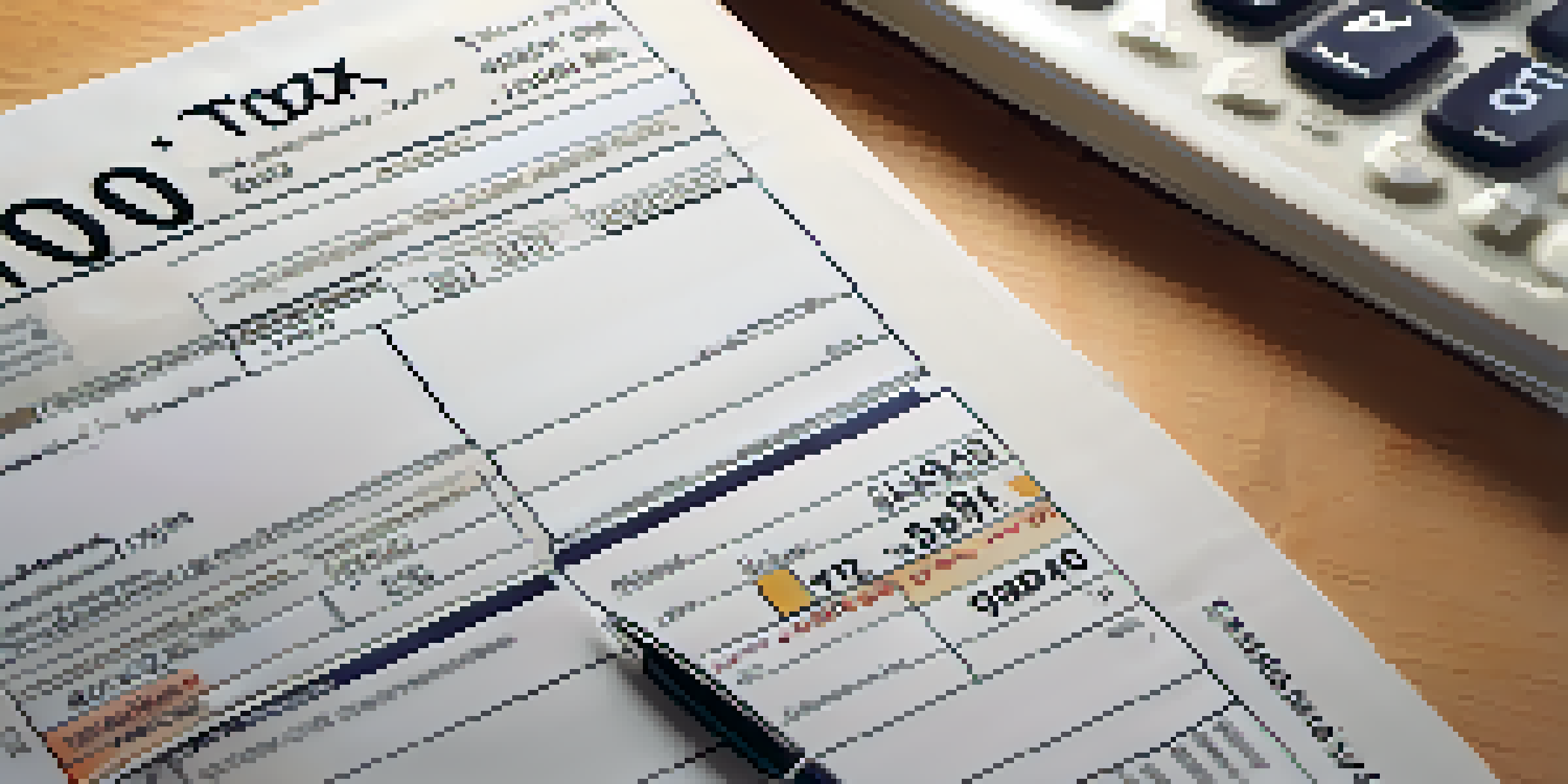What You Need to Know About 1099-B for Capital Gains

What is a 1099-B Form and Why is it Important?
A 1099-B form is a tax document used to report proceeds from broker transactions, such as the sale of stocks and other investments. It's essential for taxpayers who have sold securities throughout the year, as it provides the IRS with detailed information about their capital gains and losses. Understanding this form can help you ensure accurate reporting and compliance with tax laws.
The only thing certain in life is death and taxes.
When you sell an investment, your broker sends you a 1099-B to summarize the transactions. This form includes details like the date of sale, the sale price, and the cost basis, which is what you initially paid for the asset. By having this information organized, you can better track your investment performance and make informed financial decisions.
In short, the 1099-B not only helps the IRS track your earnings but also serves as a crucial tool for you as an investor to understand your financial health. So, if you've engaged in any trading activities, keep an eye out for this form come tax season!
Understanding Capital Gains and Losses
Capital gains occur when you sell an asset for more than you paid for it, while capital losses happen when you sell an asset for less than its purchase price. These gains and losses are essential for determining how much tax you owe on your investments. The IRS categorizes them as short-term or long-term, depending on how long you held the asset before selling it.

Short-term capital gains apply to assets held for one year or less and are taxed at your ordinary income tax rate. Conversely, long-term capital gains, from assets held for more than a year, are usually taxed at a lower rate, making it beneficial to hold onto investments longer. Understanding these distinctions can greatly affect your overall tax liability.
Understanding 1099-B Importance
The 1099-B form is crucial for reporting investment sales and calculating capital gains and losses for tax purposes.
Using the 1099-B form, you can calculate your net capital gain or loss by subtracting your total capital losses from your total capital gains. This calculation is critical, as it directly impacts how much tax you owe and can even influence your investment strategies moving forward.
Key Information Included in a 1099-B Form
The 1099-B form contains several important sections that provide a comprehensive overview of your transactions. Key information includes the description of the security sold, the date of acquisition, the date of sale, the sale proceeds, and the cost basis. Each of these elements is crucial for calculating your capital gains or losses accurately.
An investment in knowledge pays the best interest.
One of the standout features of the 1099-B is the distinction between covered and non-covered securities. Covered securities have their cost basis reported to the IRS by the broker, while non-covered securities do not. This means you may need to keep additional records for non-covered securities to determine your cost basis accurately.
Having a clear understanding of what each section of the 1099-B means will prepare you for filing your taxes and ensure that you report all necessary information to the IRS correctly. It also helps you avoid potential pitfalls, such as misreporting your gains or losses.
How to Use Your 1099-B for Tax Filing
When tax season arrives, using your 1099-B form to file your taxes can seem daunting, but it doesn't have to be. Start by gathering all your 1099-B forms from different brokers and organizing them by the transaction date. This organization will help streamline your calculations and ensure you don't miss any important details.
Next, you'll need to calculate your total capital gains and losses using the figures provided on your 1099-B. If you're using tax software, it will often prompt you to enter this information directly, simplifying the process. If you're doing it manually, remember to carefully follow the IRS guidelines for reporting capital gains and losses.
Key Details in 1099-B Form
Important sections of the 1099-B include sale proceeds, cost basis, and the distinction between covered and non-covered securities.
Lastly, after completing your calculations, make sure to double-check your work. Accuracy is key, as mistakes can lead to audits or increased tax liability. If you're unsure about your calculations, consider consulting with a tax professional to ensure everything is in order.
Common Mistakes to Avoid with 1099-B
Filing your taxes can be tricky, and there are several common mistakes taxpayers make with their 1099-B forms. One of the most frequent errors is misreporting the cost basis, especially for non-covered securities. If you don't accurately report your cost basis, you could end up paying more taxes than necessary.
Another mistake is overlooking short-term versus long-term gains. As mentioned earlier, the tax rates for these two categories differ significantly. Failing to categorize your gains correctly can lead to overpayment of taxes, which is why it's crucial to pay attention to how long you've held your investments.
Additionally, some taxpayers forget to include all 1099-B forms from various brokers. If you've traded with multiple brokers, ensure you've accounted for every transaction. Keeping thorough records throughout the year can help you avoid these pitfalls come tax season.
The Importance of Keeping Accurate Records
Accurate record-keeping is vital for anyone involved in investing, especially when it comes to capital gains and the 1099-B form. By maintaining detailed records of your transactions, including purchase prices, sale dates, and any associated fees, you create a clear picture of your investment history. This diligence pays off when it comes time to file your taxes.
Good record-keeping also helps you track your performance as an investor. By analyzing your gains and losses over time, you can make informed decisions about future investments. It allows you to identify patterns in your trading behavior and adjust your strategies accordingly.
Avoiding Common Tax Filing Mistakes
Common errors with 1099-B forms include misreporting cost basis and overlooking the categorization of short-term versus long-term gains.
Moreover, having accurate records can protect you in case of an IRS audit. If you can provide clear documentation of your trades and their associated costs, you're less likely to face penalties or additional taxes. It’s worth the effort to stay organized!
When to Seek Professional Help for 1099-B Issues
While many people can handle their taxes, there are times when seeking professional help with 1099-B forms is wise. If your investment situation is complex, such as dealing with multiple brokers, various types of securities, or numerous transactions, a tax professional can help navigate the intricacies. They can ensure that you're maximizing your deductions and minimizing your tax liabilities.
Additionally, if you find yourself confused by the details on your 1099-B, don't hesitate to reach out for assistance. Understanding cost basis calculations, short-term versus long-term gains, and potential tax implications can be overwhelming. A tax advisor can clarify these points and provide personalized advice.

Lastly, if you've received a notice from the IRS regarding discrepancies on your tax return, it's crucial to consult a professional. They can help you resolve the issue and represent you in discussions with the IRS, ensuring your rights are protected.